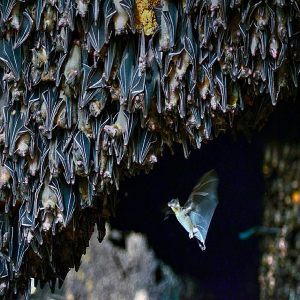Does size matter? Bat diversity and the use of rock shelters in Brazil

All claims expressed in this article are solely those of the authors and do not necessarily represent those of their affiliated organizations, or those of the publisher, the editors and the reviewers. Any product that may be evaluated in this article or claim that may be made by its manufacturer is not guaranteed or endorsed by the publisher.
Accepted: 5 April 2023
Authors
A positive correlation between cave size and bat diversity has been recorded by some authors for different cave areas in South America. We analyzed published and otherwise available data from three Brazilian karst areas and phytogeography domains, including NE and SE Atlantic Forest and Cerrado (savannah-like vegetation), encompassing a wide range of cave sizes. We found no such correlation, as expected in view of previous observations by researchers and speleologists. We discuss the ecological implications of different ways to measure bat diversity, i.e. the accumulative number of species (sequential use of caves) vs. the number of species at a given occasion (species in actual cohabitation) vs. bat abundance (numbers of individuals), as well as speleological topics related to the concept of caves (based on an anthropomorphic definition, not applicable to other species), the problems of estimating topographic variables such as cave area and volume, and the value of including cave temperatures in the analyses. Multiple interacting variables may influence the composition of cave bat communities and bat species richness and abundance. The most important ones would be the density of caves in a given area (related to lithology – calcareous vs. siliciclastic caves), regional climates, and degree of preservation of epigean habitat. Cave morphology, number and size of entrances, and presence of water bodies, as well as interactions with other species, must also be considered. In conclusion, as a general statement for tropical and subtropical bats, cave size (in the human sense) by itself does not matter, except perhaps for one-off situations. Finally, a brief overview of the diversity of cave bats in Brazil is presented.
How to Cite

This work is licensed under a Creative Commons Attribution-NonCommercial 4.0 International License.
PAGEPress has chosen to apply the Creative Commons Attribution NonCommercial 4.0 International License (CC BY-NC 4.0) to all manuscripts to be published.







